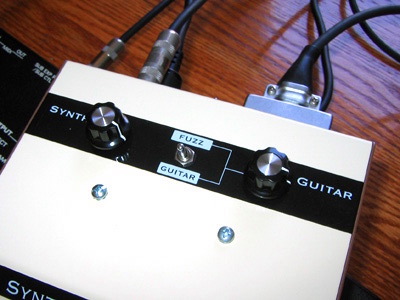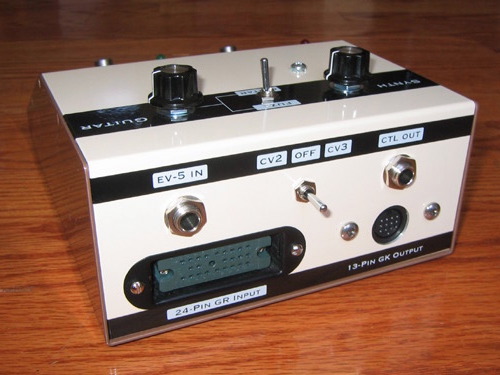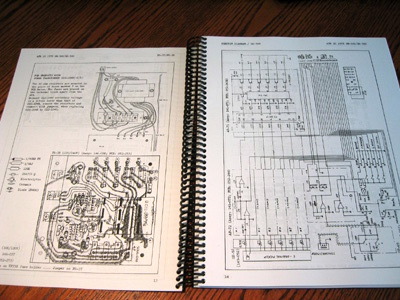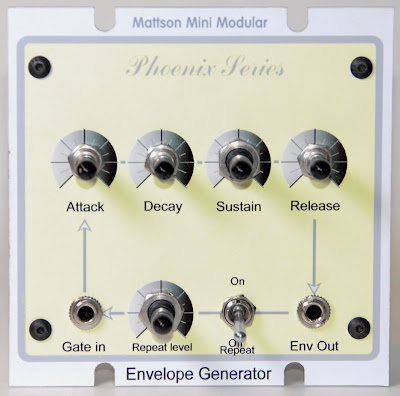 Mattson Mini Modular Sample & Hold
Mattson Mini Modular Sample & Hold

Wednesday, September 19, 2007
Arduino Punk Console - programmable 8 step tone sequencer
More info on the Arduino Punk Console here. via fotosis.
"This is my first build using an arduino microcontroller. I wanted to create a simple tone output device along the lines of the 555-based atari punk console, but using solely the mcu as the tone generator. Unfortunately, that was just too simple a task with a microcontroller to play with--it was done in about five minutes and my mind was already forging ahead with a bunch of stupid ideas."
Fairlight Xynergi Videos
MOOG Tatoo
 via Till "Qwave" Kopper in the comments of this post:
via Till "Qwave" Kopper in the comments of this post:There is a female german Moog synth player named Christa with a Minimoog tatoo on her right arm near the shoulder. Here is a picture shot during the Kufstein BlueSynth meeting two weeks ago."
Studio 35d's Analogy
 "The Analogy sampler CDs are compilations of tracks sent in by various artists with music made with analog electronic music instruments only. Use of any digital instruments, such as samplers and digital synthesizers are not allowed. Because of the succes of both volumes 1 and 2, it was a logical step for Groove Unlimited to continue the series with Analogy Volume 3."
"The Analogy sampler CDs are compilations of tracks sent in by various artists with music made with analog electronic music instruments only. Use of any digital instruments, such as samplers and digital synthesizers are not allowed. Because of the succes of both volumes 1 and 2, it was a logical step for Groove Unlimited to continue the series with Analogy Volume 3."The track Probe One (original version here), by Studio 35D features only the Pro-One according to My Synthesis Technology.
click here for more info.
Ursa Major Recording Studio

click here for more. Via Analog Industries HCGP.
Spot the synths.
Update via the comments:
"This is David Morley's studio (he has also produced stuff with Andrea Parker). He uses the ARP 2600 on just about everything, and it sounds wonderful. He also has a nice collection of reverbs (couple real EMT plates, Roland R-8, etc) that he really knows how to use.
His new CD is one of my favorite electronic releases of the year. The sounds and moods he creates are very inspiring. Very much worth picking up, I think you have to order it directly from him.
http://www.davidmorley.com/"
Bingoboys Studio for Sale
 This one in via burnie:
This one in via burnie:"the studio in the first district of vienna of the producer collective bingo boys is for sale or rent now. as far as i know they had some massive chart success in europe with lets say kind of commercial productions, and with their single "show me how to dance" i think they even reached us top 5. also georg luksch and peter rauhofer did remix jobs for madonna and got an emmy for this...
but maybe more interesting for you and other synthheadz, there was a nice feature of georg lukschs gear and him talking about the difference of touching real gear or doing it virtually , like making an instant soup or do real cooking, on the dvd of in the german magazine sound&recording (formerly "keyboards"), issue 4/2007 [unfortunately the article is not available online, just an abstract] also hes showing his huge gear park, including mostly all improtant synthesizers of the last two and a half decades, even switching on the emulator 2 and the fairlight... today i came across the website of the studio, and that it is going to be sold or rented."
Note the Achtung! at the bottom of the page states that the equipment is not for sale by itself.
How To Open a Waldorf Synth
SYNTH GOD
 "SYNTH GOD is a feature-length documentary film project that explores the world of synthesizers and electronic music.
"SYNTH GOD is a feature-length documentary film project that explores the world of synthesizers and electronic music.Developed over fifty years ago, the synthesizer is essentially an electronic sound generator that can produce an infinite spectrum of sound colors. This one seminal idea – in its many incarnations and applications – has shaped modern music and culture and profoundly altered our contemporary soundscape.
SYNTH GOD is a search for the influence and power of the synthesizer in our everyday sound environment. The concept is not simply a contest of musicians or keyboardists. The gods of synth can manifest in the minds of artists, inventors, performers, composers and sound designers as well as inside transistors, vacuum tubes, lines of computer code, ringtones and video games.
Comprised of interviews, live concert footage, archive clips, animation, behind-the-scenes tours of small indie workshops and giant synthesizer factories, SYNTH GOD is set to film in the U.S., Japan and Europe under the direction of Hans Fjellestad, whose past films include MOOG (2004)."
Click here for more info.
Kelly Osbourne Has a Synth Tatoo?
 via Perez Hilton, via catsynth.com.
via Perez Hilton, via catsynth.com.Synth Babe tag for both Kelly and Perez. BTW, how many of you know who Perez is? Just curious. My wife is addicted to his blog and I've been known to look. Never thought I'd get a post from it though.
Update: I swore I saw this one before. Turns out I did on Music Thing. Link. But it was just the close-up of the arm back then.

SEKU Analog Sequencer
YouTube via sigmambient.
"Self made analog step sequencer controls Korg MS10 and Roland S100M synthesizers. First row controls MS10 pitch and S100M noise-drum gate. Second row controls MS10 filter-cutoff. Synthesizer sounds are modified live when sequence is running. More information about SEKU and Sigma on www.studiomanus.com"
Korg MS-20 - Endless random triggered space loop
YouTube via Newueel.
"Another 'endless' loop...
With many thanks to an anonymous comment at http://matrixsynth.blogspot.com/ on the previous movie (Endless Space Loop):
"Anonym ous said...
Also try patching a noise output to the ESP and taking the random trigger outputs from that."
Never used the ESP for this kind of purposes and I like it a lot! Had lots of fun already!
So the noise generator is used to get a random trigger. This trigger is also used for clocking the sample & hold using the EG2 reversed output.
Later on the MG is clocking the sample & hold combined with a slower random trigger.
If you're interested check out the patch info below:
KNOBS:
VCO1: [Rectangle] [very narrow] [16']
VCO2: [Rectangle] [-2/-3] [2']
PORTAMENTO: [0]
VCOMIX: [10] [ 0] [10] [ 0]
HPF: [ 2] [ 5] [10] [ 0]
LPF: [ 5] [ 8] [10] [ 0]
MG: [(max to the right)] [8]
EG1: (n/a)
EG2: [0] [0] [10] [5] [0]
ESP: [6] [(n/a)] [(n/a)] [(n/a)] [5]
ESP Note: Only SIGNAL IN and TRIG OUT are used. SIGNAL LEVEL (about 6) and THRESHOLD LEVEL (about 5) is a very precise combination. Each SIGNAL LEVEL requires the appropriate THRESHOLD LEVEL. Changing the SIGNAL LEVEL will change the interval for the random trigger. The THRESHOLD LEVEL changes the length of the trigger.
USED PATCHES:
(random trigger:)
1. NOISE GENERATOR (WHITE) -> ESP (SIGNAL IN)
2. ESP (TRIG OUT) -> (TRIG IN)
(random sounds:)
3. ENVELOPE GENERATOR 2 (REV OUT) -> SAMPLE & HOLD (CLOCK)
4. NOISE GENERATOR (PINK) -> SAMPLE & HOLD (IN)
5. SAMPLE & HOLD (OUT) -> VOLTAGE CONTOLLED OSCILATOR 1 (TOTAL)
(later:)
Replace 3. by MODULATION GENERATOR (OUT RECTANGLE) -> SAMPLE & HOLD (CLOCK)"
Thanks for the thanks Newueel!
AH Bay Area Gathering 2007 - Cary Roberts' Serge and Blacet
YouTube via therealretrosynth.
"Cary Roberts' Serge, Blacet, and MFB gear driven by Doug T's Serge TKB at the Analogue Heaven Bay Area gathering in Oakland CA on Sept 9 2007."
BX-13 V3 Expanded Bus Converter Version 3
 images via this auction.
images via this auction."For about ten years, Roland Corporation and other manufacturers produced a range of unique, very high quality 24-pin guitar synthesizer controllers. With the advent of the contemporary Roland 13-pin standard, vintage guitar synth owners could only access the latest in guitar synthesizer technologies with the incredibly rare, hard-to-find Roland BC-13 Bus Converter.
The BX-13 V3 is the answer for vintage guitar synthesizer players who want to access modern guitar synthesizer technology while playing their treasured vintage guitar synth controller. The BX-13 V3 is more affordable than the typical "collector" prices on the Roland BC-13, and it has more features.
As you can imagine, it is almost impossible to quickly and accurately turn guitar and synth signals on and off.
The BX-13 V3 improves on the BC-13 by adding two dedicated foot switches with LEDs instead of using the Resonance knob. One foot switch is for Synthesizer Output, and one is for Guitar Output. Nothing could be simpler for controlling the outputs of your Synth and Guitar signal. In addition, the BX-13 V3 in enclosed in a rugged, stomp-box type enclosure. The BC-13 is an inline design, basically a giant lump in the middle of your guitar cable, much like the AC transformers popular with some manufacturers.
Top Panel Controls
The BX-13 V3 adds top panel controls for synthesizer and direct (humbucker) guitar output, plus a switch to select from guitar or hex fuzz sound for Roland G-202, G-303, G-505, or G-808 players. All three outputs can be accessed by selecting the hex fuzz sound with the BX-13 V3 and using the 1/4” Guitar output jack on the guitar.
A look at the schematics of various Roland guitar controllers reveals that no two are wired exactly the same. Likewise, the internal circuitry of a Roland GI-10, GI-20 and GR-20 differs with each unit. As a result, maximum volume levels can change with different guitars or different synthesizers. The original BX-13 used a "one-size-fits-all" calibration like the BC-13. Now, the BX-13 V3 adds a top panel control to easily fine-tune to synth volume output for maximum sensitivity and maximum output.
The BX-13 V3 also adds a top panel control for the direct (humbucker) output of the guitar as well. With the original Roland BC-13 and BX-13 this volume was fixed. Also, if you are using a Roland G-202, G-303, G-505, or G-808 you can also select the hex fuzz guitar output instead of the direct (humbucker) output. And, by plugging a Roland EV-5 volume pedal into the BX-13 V3 you can control the volume of the direct (humbucker) or hex fuzz output.
Buffered Electronic Connections:
The early Roland Guitar synth controllers, such as the G-202, G-303, G-505 and G-808, do not buffer the output of their volume controls. Later guitars, like the Roland G-707 and the Ibanez IMG2010, added a buffer stage to their volume controls. As a result, early guitars tend to "load" the input to the Roland BC-13, resulting in only 80 to 90 percent of the full volume output.
The BX-13 V3 solves this problem by adding an electronic buffer stage for the volume signal. The electronic buffer stage isolates the volume control signal so that any vintage guitar works smoothly with any modern guitar synthesizer.
 Inputs and Outputs
Inputs and OutputsLike a Roland BC-13, the BX-13 V3 has a 24-pin Guitar Synth a 13-pin Guitar Synth output connector. With only the 24-pin cable plugged in, the level of the direct (humbucker) guitar sound is controlled by the top panel guitar volume knob, and by the optional EV-5 volume pedal. If you want to vary the level of the direct (humbucker) sound using the volume knob on the guitar, then a second cable is connected from the 1/4” Guitar output jack on the Guitar Controller to your mixer or amplifier.
Compatible with Vintage Bass Guitar Synthesizers:
The BX-13 V3 has also been thoroughly tested with the vintage Roland bass guitar synthesizer controllers like the G-88. To test for compatibility, the G-88 was plugged into the BX-13 V3, then the BX-13 V3 was connected to a GI-20. The Roland GI-20 supports bass guitar synths with a switch on the back panel for bass operation.
Other Roland guitar synths, such as the GR-50 may not work properly, since they were not designed to handle to lower frequencies of a bass guitar.
Roland Vintage Guitar Service Manuals - 1978-1989

images via this auction.
"econd Edition! With BX-13 Series Schematics! Plus Complete Technical Specifications, Parts Listings, Schematics and More of ALL Roland Vintage Guitar Synthesizer, Controllers! Vintage 24-pin and Earlier Synthesizers Included! Almost 300 pages!
# Guitar Synthesizer/Guitar:
# 001-030 GS-500/GR-500
# 031-054 SPV-355
# 055-072 GR-100
# 073-098 GR-300, G-303/G-808

# 099-122 GR-33B/G-33/G-88
# 123-150 GR-700
# 151-180 GR-77B
# 181-200 GM-70
# Guitar:
# 201-210 G-202
# 211-222 G-505
# 223-232 G-707
# 233-238 G-77
# Other:
# 239-244 GK-1
# 245-266 LPK-1/STK-1
# 267-268 US-2
# 269-272 BC-13
# 273-276 NEW This Edition! BX-13 Versions 1, 2 and 3
Be sure to check out the sellers' other items.
Roland GR-88 Bass Guitar and GR-33
"This is a complete Early 1980's Roland GR-series bass guitar synthesizer system. Included is an Ibanez-built G-88 bass guitar synthesizer controller with original hardshell case, Roland GR-33B bass synthesizer, 24-pin cable, and original manual.
The G-88 was Roland's deluxe neck-through-body (ash and walnut) model, with a maple and mahogany neck with an ebony fretboard, polycarbonate nut, active EQ, Gotoh tuners, 34" scale, one single-coil pickup, and one Roland synth pickup. Neck width is 1-11/16", body width 13", body depth 1-3/4" and overall length is 45-1/2".
For more specs visit this great Roland synthguitar website (includes video demonstrations!). This bass has both regular 1/4" and 24-pin Roland output plugs, so it can be played as a conventional electric bass with a standard cord, and as a synthesizer controller guitar (standard guitar sounds also pass through the 24pin cable). Please note: this is not a recent GK guitar, it will not work with recent GK-compatible Roland guitar synthesizers as it does not have a GK2 or GK3 pickup. There may be some Roland adaptor units available, you will have to do the research on this.
The GR-33 is a fantastic-sounding synth with an awesomely resonant multimode filter (reminds me of a 303), plug in a voltage control pedal (not included) for some mindblowing hands-free sweeps and wah sounds! The controls for filter cutoff and resonance are on the bass so these settings are right at your fingertips. The synth is housed in a rugged, gig-worthy steel casing. As noted all synth functions work exactly as they should, this system is quite inspiring to play and the synth-response is lightning fast!
You can download the GR-33B manual here"
PREVIOUS PAGE
NEXT PAGE
HOME













© Matrixsynth - All posts are presented here for informative, historical and educative purposes as applicable within fair use.
MATRIXSYNTH is supported by affiliate links that use cookies to track clickthroughs and sales. See the privacy policy for details.
MATRIXSYNTH - EVERYTHING SYNTH













© Matrixsynth - All posts are presented here for informative, historical and educative purposes as applicable within fair use.
MATRIXSYNTH is supported by affiliate links that use cookies to track clickthroughs and sales. See the privacy policy for details.
MATRIXSYNTH - EVERYTHING SYNTH








































